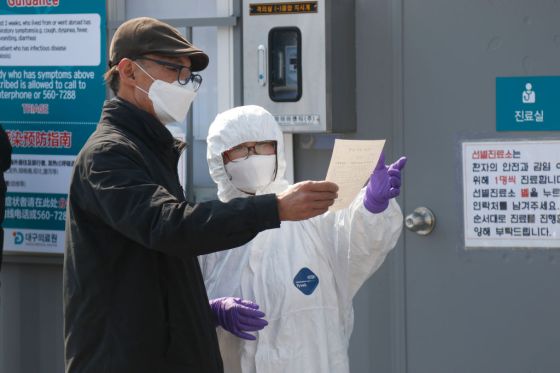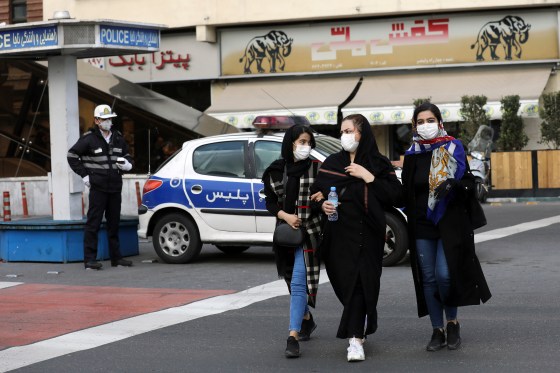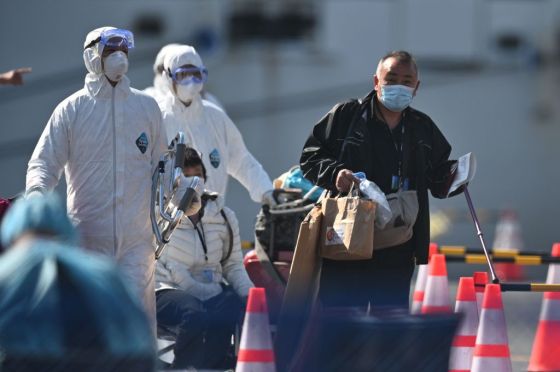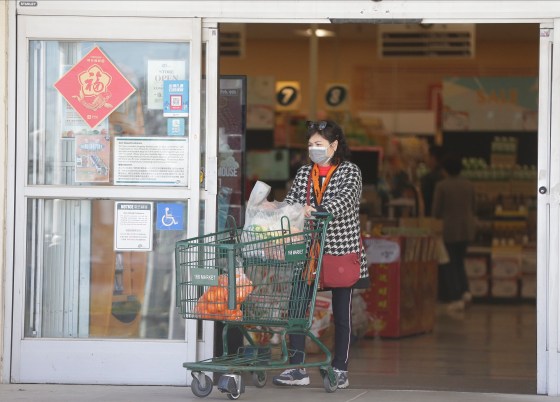A surge in deadly coronavirus cases outside China is raising concerns that the outbreak has reached a new stage and could continue its global spread to even more vulnerable countries.
In the central Chinese province of Hubei, where the virus is believed to have originated, the number of cases appears to be stabilizing, according to government figures. But the number of people infected elsewhere in the world is rising quickly, with clusters in South Korea, Italy, Iran and a cruise ship docked in Japan.
As of Monday, more than 2,200 cases of the virus, officially called COVID-19, have been reported outside of mainland China, where the overwhelming majority of the 79,000 cases have been located since officials first discovered the disease in December. The number of deaths outside China has also increased to 166, including 50 in Iran and four in Italy.
In a news conference Monday, World Health Organization (WHO) Director-General Tedros Adhanom Ghebreyesus said the WHO is “worried about the situation in the Islamic Republic of Iran and in Italy.”
Although there have been a handful of people infected in more than 25 countries, the number of cases outside China remained in the hundreds for weeks, before jumping to around 1,000 cases on Feb. 18. But in the last few days, the number of infected people has skyrocketed in several countries, sparking fears that the virus could take root outside China.
“There looks to be sustained community transmission [outside China],” Raina MacIntyre, head of the University of New South Wales’ Biosecurity Research Program, tells TIME.
The new global spread of the coronavirus may be attributable to the difficulty of detecting infected travelers. The virus’ incubation period—the 3 to 14 days it usually takes before symptoms begin to show—and its often mild symptoms make it difficult to find with measures like thermal screening, which has been rolled out at airports across the world. A study by researchers at the London School of Hygiene and Tropical Medicine estimates that 46 out of 100 infected travelers will be able to pass undetected through both exit screening at their departure destination and entry screening at their arrival location.
The WHO is warning that the window of opportunity to stop the coronavirus outbreak is shrinking. It took draconian measures, including locking down cities with tens of millions of people, before infection numbers began to fall in China.
Here’s what to know about where else the virus is spreading.
South Korea

On Monday, South Korea confirmed that the number of cases of COVID-19 in the country had climbed to 833, with seven deaths.
More than half of the cases are in the southwestern city of Daegu, where the coronavirus spread rapidly through the Shincheonji Church of Jesus, a mysterious religious group.
More than 9,000 members of the eccentric religious group are in quarantine. The church, which claims about 200,000 followers in South Korea, said it has closed all of its 74 centers around the country and told followers to instead watch its worship services on YouTube.
Cases have also been reported in Gwangju, a city in the southwest, and the island of Jeju off the south coast, raising fears of a broader spread of the virus.
Daegu Mayor Kwon Young-jin on Feb. 20 urged the city’s 2.5 million people to stay home and wear masks even indoors if possible.
“If authorities fail to contain the spread of the COVID-19 in Daegu, there is a high possibility that COVID-19 could spread nationwide,” Vice Health and Welfare Minister Kim Gang-lip told reporters, according to Yonhap News Agency.
Iran

The sudden announcement by Iran of several deaths from coronavirus last week startled the global public health community.
The outbreak in Iran has centered mostly on Qom, a city of about 900,000 people approximately 90 miles south of the capital Tehran, but cases have spread over the last few days to four other cities, including to Tehran. On Monday, officials raised the death toll in Qom to 50, including deaths as far back as Feb. 13. This would make Qom’s death toll higher than anywhere in the world outside Hubei province in China.
Despite this, Iran has only confirmed 47 cases of the virus, according to the semi-official ILNA news agency.
Experts also worry that cases in Iran could spill over to neighboring countries. Qom is a holy city and pilgrimage site for Shi’a Muslims.
“The concern is Iran’s borders with Pakistan and Afghanistan. I understand the borders are quite porous and difficult to police. If it gets into Pakistan, the Indian subcontinent, that’s a real concern because you’re moving towards these very highly populated areas,” says MacIntyre, the University of New South Wales researcher.
Italy

The number of cases in Italy more than quadrupled over the weekend, with more than 200 confirmed cases and four deaths as of Monday morning. The outbreak, concentrated in the wealthy northern regions of Lombardy and Veneto, represents the biggest cluster of cases in Europe. The country has not yet identified “patient zero,” raising alarm about how widely the disease has already spread.
In a scramble to contain the unprecedented outbreak, authorities have placed at least 10 towns on lockdown, affecting at least 50,000 people. Schools, museums and cathedrals across the region are shut.
Japan

As of Monday, Japan has almost 850 confirmed coronavirus cases, 691 of which are passengers and crew from the virus-stricken Diamond Princess cruise. Three people have died. The cruise was quarantined for 14 days until Feb. 19 after the company learned that the ship had previously carried a coronavirus patient.
With almost 20% of people who were on the ship infected, the quarantine measure has been heavily criticized by health experts as having exacerbated the outbreak. Rodney Rohde, a professor and chair of the Clinical Laboratory Science Program at Texas State University, tells TIME that a quarantine on land would likely have resulted in a smaller number of infections.
“I refer to quarantined ships as floating petri dishes because you’re enclosing a living microbial agent with thousands of people in a small area,” Rohde says. Confirmed cases include passengers and crew from Japan, the U.S., the U.K., the Philippines, India and Hong Kong, among others.
Most passengers have been allowed to leave the ship—many for chartered flights home, where they are undergoing another 14-day quarantine. The crew, however, remains on board.
Off the ship, Japan has at least 147 diagnosed with the virus and one death. One cluster involves a Jan. 22 river cruise in Tokyo organized by an independent taxi drivers’ union. Eleven people from the boat were infected, and a number of cases in the country were linked back to those who caught the virus on the boat. In another cluster, four people from the central prefecture of Aichi were infected after traveling back from Hawaii. Katsunobu Kato, Japan’s health minister, said last week that the country had entered a “new phase” of the outbreak.
United States

The U.S. has now confirmed 35 cases of COVID-19, but 21 of those are Americans who were infected overseas and have been repatriated back home. Eighteen of those infected are from the virus-stricken Diamond Princess cruise ship, and three others were evacuated from China.
“We are keeping track of cases resulting from repatriation efforts separately because we don’t believe those numbers accurately represent the picture of what is happening in the community in the United States at this time,” Dr. Nancy Messonnier, director of the Centers for Disease Control and Prevention (CDC) National Center for Immunization and Respiratory Diseases, told reporters Friday.
According to CDC officials, at least ten other American ship passengers have tested positive for the virus, and will likely be added to the official U.S. count once the results are verified.
There were around 400 Americans aboard the ship, where cases of COVID-19 soared after the boat was placed under quarantine in the Japanese port of Yokohama in early February, making it the largest cluster of the novel coronavirus outside mainland China.
No comments:
Post a Comment